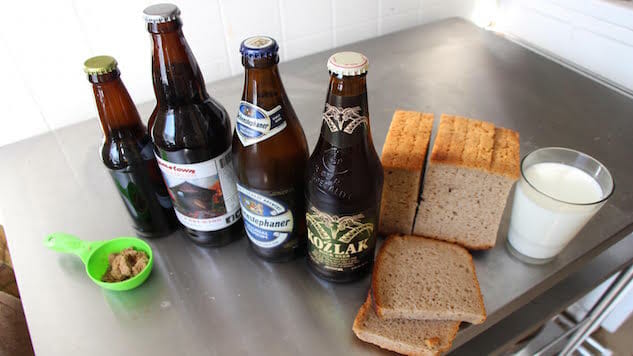Beer Porridge Finds a Fresh Update Four Centuries after Its New York Debut
Photos by Molly Jean Bennett
Porridge fervor is on the rise. So are all things hygge. But it wasn’t in the context of trendy ancient grains or Northern European coziness that I first encountered beer porridge—I read about it in a history book. The book in question was Joy Santofler’s excellent Food City: Four Centuries of Food-Making in New York. “Dutch desires structured the enduring pyramid of food-making in New York—bread, meat, sugar and especially beer,” she writes in the introduction. “The settlers poured lager over their porridge.” Lager over porridge. My brain immediately supplied the bleak visual of a can of Bud Light being emptied onto a bowl of lumpy oatmeal. As with many things that initially disgust me, I wanted to know more.
Santlofer doesn’t say more about beer porridge in particular, but there’s plenty to glean from her description of the Dutch settlers’ diet. Initially, they rejected locally available foods and relied on imports from the Dust West India Company. According to Santlofer, many of the Dutch who touched down in New Amsterdam in the early 1600s came to trade fur, tobacco and lumber. They had no interest in learning to farm, hunt or gather.
Eventually, though, as the settlement grew and more people contemplated longer stays, they began to grow grain in order to produce locally the beer and fresh bread they missed from home. The area at the present-day intersection of John and Williams Streets was a wheat field called Golden Hill. Settlers also traded with the local Lenape tribe for corn, from which they might have made a porridge called suppawn. Did they pour beer over it? Hard to say. There are a great many versions of Northern European beer porridge that the Dutch might have brought to the Americas. The porridge would have likely been made with low-alcohol “small beer” that men, women and children drank all day because it was safer than water. Refined sugar would probably not have been an ingredient before the mid-1600s, when the escalation of the brutal Caribbean sugar trade made it accessible to more consumers. While I wasn’t able to arrive at the exact porridge of old New York, Santlofer peaked my curiosity in the beer porridge landscape.
Øllebrød at the Great Northern Food Hall
I first set out to try a professional variety. The much-lauded Great Northern Food Hall, I learned, is serving up a fresh take on Danish beer porridge in Grand Central Terminal. Their dessert porridge, called øllebrød, is the most interesting thing I’ve eaten in recent memory. The porridge itself is cool and smooth, almost like a pudding, with occasional clumps of chewy rye bread. With malt and citrus flavors dominating, it’s hard to fully discern beer’s contribution. The toppings are where things get really wild. First, there’s the mild, silky cloud of vanilla milk foam. Then come the sea buckthorn berries—tiny orange bursts of tartness. Finally, the porridge is sprinkled with a hailstorm of crunchy caramelized rye crumbs and tarragon sugar. The overall effect is a dish that’s incredibly complex in both texture and flavor. Verdict: a delectable treat.
-

-

-

-

-

-

-

-

-

-

-

-

-

-

-

-

-

-

-

-

-

-

-

-

-

-

-

-

-

-

-

-

-

-

-

-

-

-

-

-

 Photo by Molly Jean Bennett
Photo by Molly Jean Bennett Photo by Molly Jean Bennett
Photo by Molly Jean Bennett






































